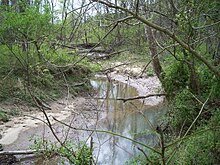Casey Creek (Illinois)
| Casey Fork | |
|---|---|

Headwaters of Casey Fork Creek in Southern Illinois
|
|
| Basin features | |
| Main source |
Haines Township, Marion County, Illinois 38°29′12″N 88°54′50″W / 38.4867155°N 88.9139508°W |
| River mouth |
Confluence with Big Muddy River in Rend Lake 38°05′27″N 88°57′24″W / 38.0908831°N 88.956736°WCoordinates: 38°05′27″N 88°57′24″W / 38.0908831°N 88.956736°W |
| Physical characteristics | |
| Length | 39 mi (63 km) |
Casey Creek is a major tributary of the Big Muddy River in Illinois, United States. It is about 39.0 miles (62.8 km) long, measured from the junction of its arm of Rend Lake with the arm formed by the Big Muddy River.
Casey Creek is shown on federal maps as Casey Fork, following a 1967 decision by the U.S. Board on Geographic Names. It is named for Zadok Casey, a congressman from Illinois in the early 19th century.
Casey Creek rises in Marion County, between Iuka and Kell. It flows southward through the center of Kell as a small creek.
Like most of the rest of the Big Muddy basin, Casey Creek flows through an ancient lake bed from the Wisconsin glaciation. This gives it a broad, flat floodplain that is filled with shallow water in wet weather. Heading south, the lake bed becomes recognizable about 10 miles (16 km) north of Mt. Vernon, as flat ground that meets the older hills at an abrupt angle. In the north, the flat valley bottom is only a few hundred feet wide, but it widens toward the south.
The Union Pacific Railroad follows Casey Creek from Kell down to Mt. Vernon. This railroad was originally built as the C&EI around 1909. The railroad crosses the creek several times during its descent to Mt. Vernon. This route includes several cuts into the hills adjacent to the creek, resulting in bluffs.
The Norfolk Southern (formerly the Southern Railway) railroad enters the Casey Creek valley, via Limestone Creek, to the north of Mt. Vernon. The two railroads enter the northeastern corner of Mt. Vernon on opposite sides of the creek. At full flood, Casey Creek rages between the two railroad embankments, which are about 3,000 feet (910 m) apart.
...
Wikipedia
